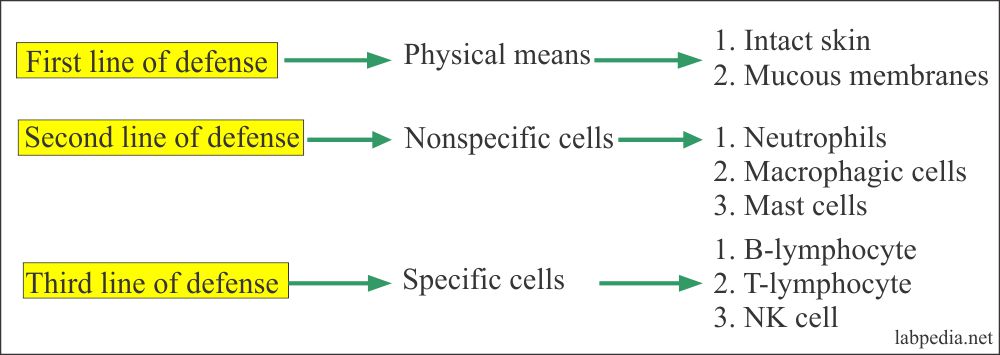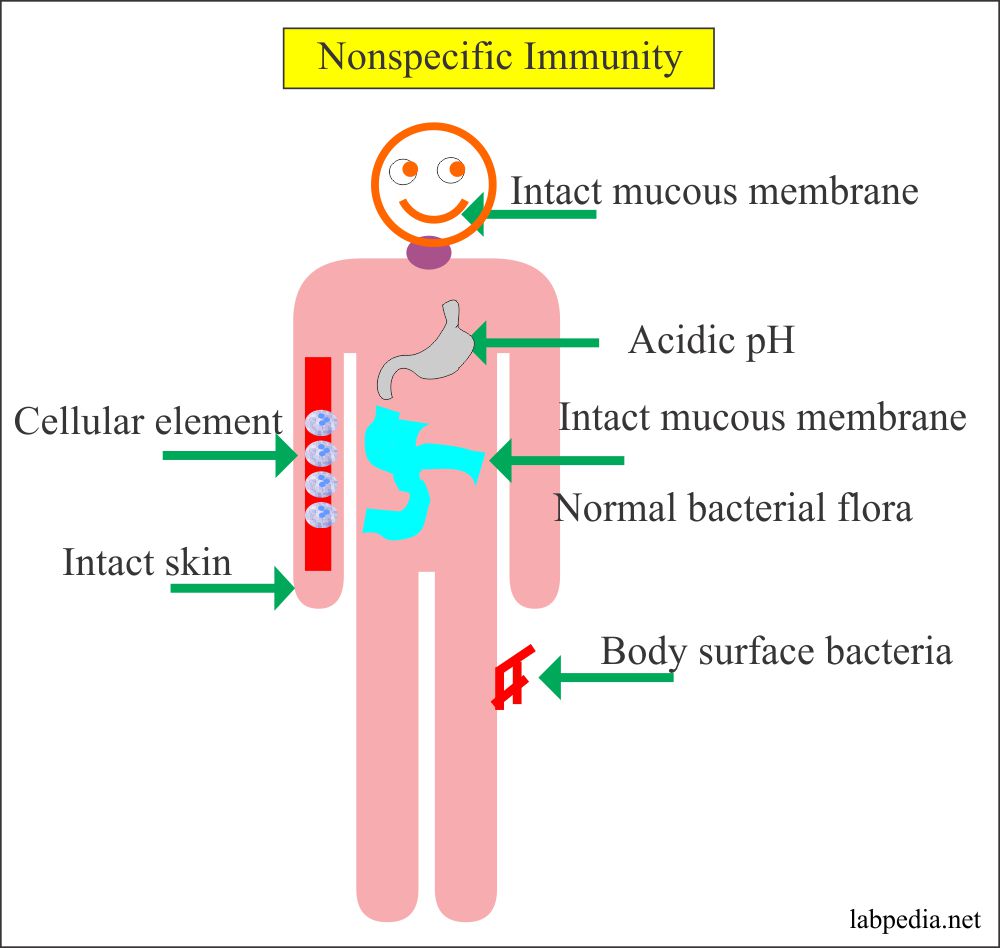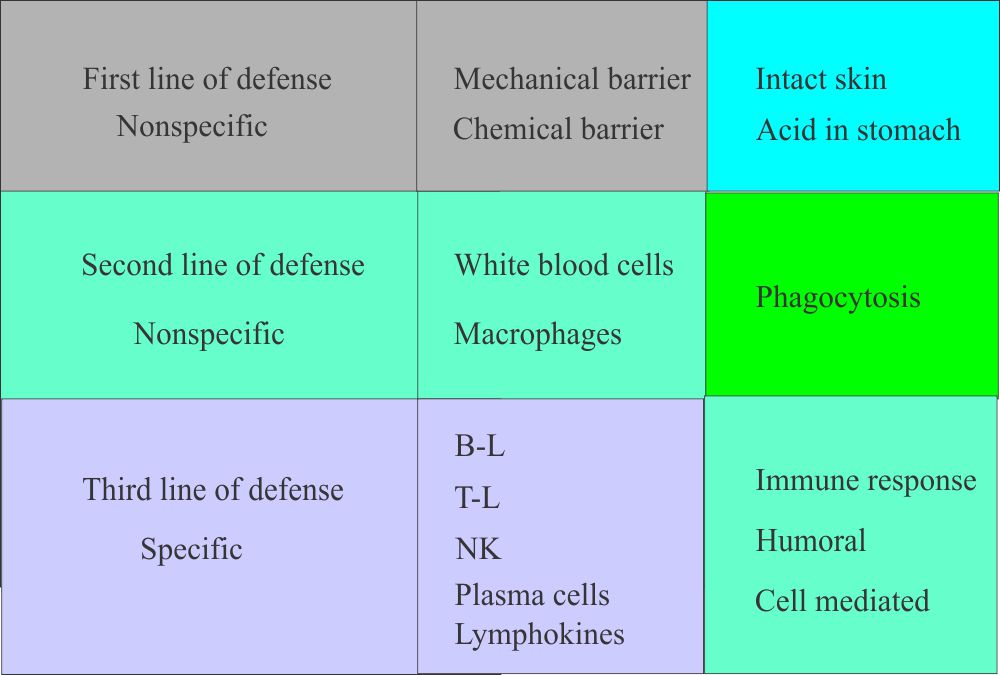Chapter 2: Innate (Nonspecific) Immunity
Definition of Immunity
The word “Immunis” means free form burden and immunitas means exemption from government taxes and this provided English term as Immunity.
Immunity:
It is a broad definition, which means that it makes us able to recognize self and non-self substances, and actually, this is a protective or defense mechanism of our body, which leads us healthy life.
Or it is inborn resistance that the body resists the infection after the microorganisms enter the body and crossed the first line of defense.
The outcome of this immunity:
Tissue damage produced by the infections or other agents will lead to inflammation which consists of biochemical and cellular changes that will facilitate the process of phagocytosis. With the help of phagocytosis, it will lead to the engulfment of the microorganisms or the damaged cells.
There is an increase in the acute phase proteins or reactants during this inflammation, these are sensitive indicators of the presence of an inflammatory process. these can be used for the monitoring of these conditions.
Types of Immunity
- Inborn or innate immunity: It is present at birth; this is the first line of defense.
- Acquired or specific: It is not present at birth but become part of our immune system as the lymphoid system develops.
1970: W.H.O. defined immunity as an immune response to antigen (Foreign body) in the form of humoral (by activation of B-lymphocytes) or cellular (by activation of T-lymphocytes).
Innate (Non-Specific) Immunity
This takes place through:
- Physical means
- Chemical
- Cellular
- Physiological
- Body surface bacteria
Physical Means
These are as follows:
- Intact skin is a barrier and prevents the entry of microorganisms, while ulcerated skin is more prone to develop an infection.
- Intact mucous membranes are also a barrier to the entry of microorganisms.
- Coughing and sneezing. This will force out the microorganism and do not allow them to settle down on the mucosa.
- Brushing and movements of cilia of columnar cells remove any pathogen settling in that area.
Chemical Means
There are so many chemicals in our body, which protect nonspecifically from the pathogens:-
- The acidic pH of the stomach (HCL) kills so many bacteria when they reach the stomach.
- The lactic acid in the skin prevents the bacteria to cause infections and this acid provides bad growth environments.
- The complement system also destroys microorganisms and other substances (Antigen).
- Acute-phase proteins are produced during febrile conditions like C-reactive protein, which is produced in the liver and in response to pyogenic bacterial infections. Its formation can increase 1000 fold in response to infections. It binds with bacteria and activates complement. Other examples are α-antitrypsin α-2 microglobulin. Fibrinogen, ceruloplasmin, and factor B.
Cellular Means
These are the phagocytic cells, which give protection and destroy the pathogens. These are:
- Professional: Neutrophils and mononuclear phagocytic cells.
- Non-professional: – These are also called facultative phagocytic cells like endothelial cells, fibroblasts, and epithelial cells. They become phagocytic whenever there is a need for them.
Natural immune system Type of the components Cellular, nonspecific, professional Neutrophils Macrophages Mast cells Cellular, Non-professional cells Endothelial cells Fibroblast Epithelial cells Humoral (nonspecific) Lysozyme Complement Interferon
Physiological Means
- Body temperature: Some bacteria have poor growth at 37oC body temperature.
- O2-tension is high in the lung, which inhibits the growth of anaerobes.
- Hormonal imbalance like an increase in cortisone decreases the inflammatory response.
- Young and aged are prone to infection.
Body Surface Bacteria can:
A. Stimulate natural antibody formation.
B. Antagonize the microorganism. The bacterial presence may:
- Compete for nutrition.
- Produce antibacterial substance.
- Inhibit the growth of bacteria in the intestine by the production of acids.
- Produce inhibitory substances like colicin and acids.
Summary of the Defense against the infection:
Whenever there is the entry of:
- Microorganisms.
- Foreign bodies.
- Injurious chemical.
- There is a body response to get rid of this foreign material by:
- Physical means like intact skin, mucous membranes, desquamated skin epithelial cells.
- Ciliary action of the respiratory epithelium (coughing).
- Urination.
- Swallowing.
- Defecation.
- Normal bacterial flora.
- Chemical inhibitors are:
- Gastric HCL with low pH of around 3.
- Lactic acid.
- Spermine.
- Lactoperoxidase.
- Bile salts.
- Secretory IgA.
- Lysozyme.
- The nonspecific factors like:
- Fever.
- Interferon.
- Complement.
- Acute-phase protein e.g. CRP, lactoferrin, α1-antitrypsin.
- The inflammatory process will start and there will be activation of various factors and also these factors come to the site of foreign substance:
- Complement system.
- Bradykinins.
- Hageman factor.
- Phagocytic cells like neutrophils, eosinophils, monocytes, and macrophages.
- Ultimately a specific immune system is activated:
- B-lymphocytes.
- T-lymphocytes.
- Plasma cells.
- Lymphokines.
- Physical means like intact skin, mucous membranes, desquamated skin epithelial cells.



